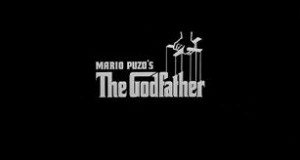Often enough, creative artists in the various fine and performing arts create works that are infused with themes and concepts that were not consciously intended when the work was aborning. In the case of Francis Ford Coppola’s “Godfather I,” however, the use of doors as metaphor, establishment of relationships, and short-term and evolving transitions is so prevalent it is hard to fathom Coppola was unaware of this cinematic approach.
There are 38 instances of the use of doors in this 1972 Oscar-winning film. And they occur throughout the cinematic narrative—starting with the opening scene with a local undertaker who asks for “justice” from “Godfather” Don Corleone following the vicious beating of his daughter by two young men, to the closing scene where a door is closed over Michael Corleone’s wife Kay’s face. The closing of the door is actually a wipe, but the impact of the right to left closing door emphasizes Michael Corleone’s rise to power as head of the Corleone family and his wife’s position as “outside” this “family.” The disparity between the “inside” Mafia family and the “outside” marital family is further underscored by the music which does not resolve, but leaves the audience aurally hanging, so to speak.
Below is a description and timing of each of the 38 scenes where the significance of doors is present.
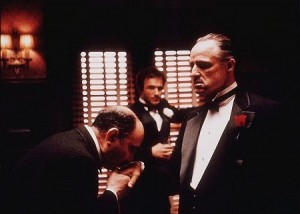 00:12:00 A local undertaker has asked the “Godfather” (Marlon Brando) for a favor with respect to his daughter who was viciously beaten by two young men because she refused their sexual advances. Don Vito Corleone accepts the request. The baker is shown to the door by Tom Hagen (Corleone’s adopted son and “family” lawyer). This is the first time in the film we see a door. It is also the first indication of the separation of the Corleone family center and the outside world. The baker is still talking to the Don Corleone as he exits the room.
00:12:00 A local undertaker has asked the “Godfather” (Marlon Brando) for a favor with respect to his daughter who was viciously beaten by two young men because she refused their sexual advances. Don Vito Corleone accepts the request. The baker is shown to the door by Tom Hagen (Corleone’s adopted son and “family” lawyer). This is the first time in the film we see a door. It is also the first indication of the separation of the Corleone family center and the outside world. The baker is still talking to the Don Corleone as he exits the room.
00:22.50 Don Corleone’s oldest son, Sonny, has left the wedding party and is having intercourse with one of the female guests, Lucy Mancini, in an upstairs room. His adopted brother, Tom, goes up the stairs and knocks on the door behind which Sonny and Mancini are engaged in carnal relations. We see Sonny’s back, and the woman’s face and upper body pressed against the door. Tom knocks on the other side of the door and tells Sonny that his “. . . old man wants to see him.”
00:28:22 Crooner Johnny Fontane, godson to Don Corleone, has been refused a part in an upcoming movie by a leading Hollywood producer, Jack Woltz. Tom Hagen is sent out to Hollywood to attempt a deal with the producer. As the two are walking off a set of an on-going film shoot, they are talking. At one point they reach an open door and the two become silhouetted against the light from the outside. Hagen intimates that if Fontane could get this movie part, Don Corleone could solve a union problem the producer is having and a cocaine issue with one of the producer’s stars. The producer accuses the Godfather of trying to muscle in to his operation. The silhouetted men are now abstracted characters becoming more two rivaling philosophies rather than a producer and a lawyer representing a client’s interests.
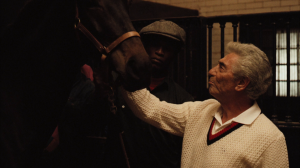 00:29:51 The producer is showing off his stable of horses to Tom Hagen. In this scene a stable boy brings a $600,000 horse out of a stall through the doors of the stall. The scene is dark. It portends a scene somewhat later when after having loudly refused to have Johnny Fontane in his movie that would “make him a big star,” the producer finds the horse’s head in his bed.
00:29:51 The producer is showing off his stable of horses to Tom Hagen. In this scene a stable boy brings a $600,000 horse out of a stall through the doors of the stall. The scene is dark. It portends a scene somewhat later when after having loudly refused to have Johnny Fontane in his movie that would “make him a big star,” the producer finds the horse’s head in his bed.
00:39:19 Here Coppola uses the closing of a door at the end of a “meeting” among Corleone insiders to punctuate the end of the scene. Just before this moment the name of Luca Brasi is mentioned. In the very next moment and the next scene, a head and shoulders shot of Luca Brasi comes into the frame from right to left, the very same way that the film’s closing door is seen—from right to left.
00:43:32 A few scenes later Luca Brasi is murdered by a rival “family.” In the next scene, Tom is seen coming out of the door of a store carrying Christmas presents (a sled under his right arm, reminiscent, perhaps, of the meaning of “rosebud” in Orson Welles’ “Citizen Kane”). He is accosted by the leader of the rival family, Virgil Sollozzo, and told to get into a car. As he comes through the door we are momentarily given a feeling of “the Christmas spirit” only to have that feeling quickly washed away when Tom is stopped by the two rival family members. You are given to think Tom will also be assassinated, but our fears are immediately assuaged when Sollozzo says “What are you worried about, Tom? If I wanted you dead, you’d be dead already.”
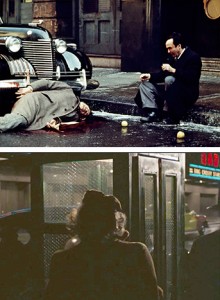 00:44:05 Another scene where a door is used as a transitional moment. In this scene Don Corleone opens a door to the street where he and his second oldest son Fredo stop to buy some fruit before going home. Moments later Vito is shot numerous times by two gunmen and presumed assassinated.
00:44:05 Another scene where a door is used as a transitional moment. In this scene Don Corleone opens a door to the street where he and his second oldest son Fredo stop to buy some fruit before going home. Moments later Vito is shot numerous times by two gunmen and presumed assassinated.
00:46:44 Michael Corleone learns of his father’s assassination when his then girlfriend (they later marry) Kay Adams spots a front page newspaper headline reporting the assassination story. Michael immediately crosses the street and enters a public telephone booth through its hinged doors. The booth re-establishes the time period of the story.
00:54:06 The family, led at this point by the oldest son Sonny is discussing what to do about the assassination attempt. At that moment an underling, Paulie Gatto, appears at the door of the room in the Vito Corleone home (apparently suffering from a cold) and from the doorway announces that there’s a package at the front door. Sonny directs Tessio to fetch the “package.” Tessio returns through the door with the package that Sonny opens up. It’s Luca Brasi’s protection vest topped by a fish. Tessio tells Sonny: “This is a Sicilian message that Luca Brasi sleeps with the fishes.” The doorway in this scene is used as if it were a stage presentation where characters can go on and off stage.
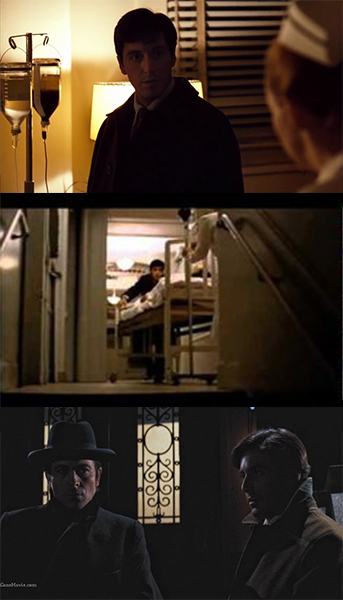 Michael Corleone opens the door of the hospital room where Vito Corleone lies recovering. The whole scene is shot over the shoulder from the hallway. When the door opens Michael is in the foreground and all we see of Vito is his head on the pillow. Michael is joined by the nurse to whom Michael queries “where is everybody.” He calls the Corleone home from the phone next to his father’s bed to inform the family that there is danger lurking. He then examines the width of the door. His plan: to move his father’s bed to another room (with the nurse’s assistance) because he knows men are coming to kill his father. The whole scene is shot through the door into the room.
Michael Corleone opens the door of the hospital room where Vito Corleone lies recovering. The whole scene is shot over the shoulder from the hallway. When the door opens Michael is in the foreground and all we see of Vito is his head on the pillow. Michael is joined by the nurse to whom Michael queries “where is everybody.” He calls the Corleone home from the phone next to his father’s bed to inform the family that there is danger lurking. He then examines the width of the door. His plan: to move his father’s bed to another room (with the nurse’s assistance) because he knows men are coming to kill his father. The whole scene is shot through the door into the room.
1:04:33 Michael, together with the nurse, move Vito Corleone’s gurney through another door into a different room. The scene is given more tension because the move cannot be quick given Vito’s condition, and the door through which they push the gurney offers some resistance.
1:05:47 We see this second room from the other side of the door through which they just went.
1:06:39 While earlier in this sequence we see an establishing shot of the outside of the hospital, including the gates and the and the stairs leading to the front doors, we never see Michael enter those doors. The scene cuts to him walking down the corridor looking for his father’s room. In this scene we see Michael coming out of the hospital doors to join Enzo the Baker whom he has persuaded to stand guard with him to thwart the approaching second assassination attempt. The scene is shot from Enzo’s point of view. On one level, the scene’s content is about Michael’s actions to protect his father. On another level, his coming out of the door is, in a way, his coming out as a leader—which by the end of Godfather I he does in fact become the new leader of the Corleone “family.”
1:08:04 Within moments of the supposed assassins coming to the hospital’s front gate by car and then leaving almost immediately once they see two people—Michael and Enzo–standing guard at the hospital, the police in several squad cars arrive at the front gates. The scene of the assassins’ car is shot from the perspective of the hospital door. The scene of the police squad cars arriving is from the perspective of the street looking at the hospital. This is also where we meet Captain Mark McCluskey for the first time. The Captain subsequently breaks Michael’s nose while the latter is held in place by two policemen. Consequently, the Captain becomes a “mark” (pun intended) when Michael kills him and Sollozzo in a restaurant.
1:09:57 Michael is rescued from Captain McCluskey’s clutches by Tom Hagan and a platoon of armed men at the end of the previous scene. In this scene we see a long shot of the Corleone compound, including the front gate that now is blocked by a chain and a car that has to be driven out of the way for any other cars to enter.
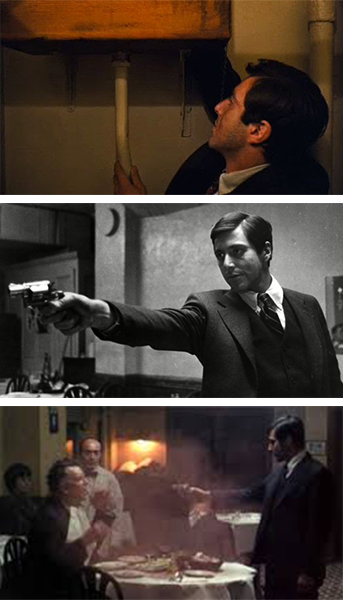 1:26:59 In a pre-arranged restaurant location, Michael meets with Sollozzo accompanied by Captain McCluskey to come to some agreement regarding Vito’s safety. This is the ostensible reason for the meeting. Michael’s actual motivation is to murder the two in retaliation. Michael excuses himself to go to the bathroom. In the bathroom, Tessio’s men have hidden a snub-nose gun with no identifying marks that Michael is to use to kill the two men. This scene is shot from the perspective of inside the stall. We see Michael entering the doors of the men’s room and then the doors of the stall. He finds the gun after some agonized searching behind the water tank of the old style pull chain toilet. The perspective stays the same as he exits the bathroom. In effect, Michael traversed four doors in this scene: entering the bathroom door, entering the bathroom stall door, and the reverse. The bathroom is fairly small, adding to the pressure that Michael must be feeling before he commits the murder he is there to accomplish. The several doors and the size of the bathroom are metaphorical in the sense that Michael must overcome his last-minute hesitancy. This is also ironic. At the beginning of the film we learn that Michael is a decorated Marine (a captain in rank). While we never learn of what actions he took to earn his medals in a war environment, Michael is still drawn into an internal ethical battle with respect to killing Sollozzo and McCluskey. The scene then cuts to an over the shoulder shot of Michael looking at Sollozzo and McCluskey eating. Minutes later they are dead. This scene then cuts to a long shot of the outside of the restaurant from the other side of the street where we see Michael exiting the restaurant’s front doors and into a waiting car to whisk him away.
1:26:59 In a pre-arranged restaurant location, Michael meets with Sollozzo accompanied by Captain McCluskey to come to some agreement regarding Vito’s safety. This is the ostensible reason for the meeting. Michael’s actual motivation is to murder the two in retaliation. Michael excuses himself to go to the bathroom. In the bathroom, Tessio’s men have hidden a snub-nose gun with no identifying marks that Michael is to use to kill the two men. This scene is shot from the perspective of inside the stall. We see Michael entering the doors of the men’s room and then the doors of the stall. He finds the gun after some agonized searching behind the water tank of the old style pull chain toilet. The perspective stays the same as he exits the bathroom. In effect, Michael traversed four doors in this scene: entering the bathroom door, entering the bathroom stall door, and the reverse. The bathroom is fairly small, adding to the pressure that Michael must be feeling before he commits the murder he is there to accomplish. The several doors and the size of the bathroom are metaphorical in the sense that Michael must overcome his last-minute hesitancy. This is also ironic. At the beginning of the film we learn that Michael is a decorated Marine (a captain in rank). While we never learn of what actions he took to earn his medals in a war environment, Michael is still drawn into an internal ethical battle with respect to killing Sollozzo and McCluskey. The scene then cuts to an over the shoulder shot of Michael looking at Sollozzo and McCluskey eating. Minutes later they are dead. This scene then cuts to a long shot of the outside of the restaurant from the other side of the street where we see Michael exiting the restaurant’s front doors and into a waiting car to whisk him away.
1:32:00 Vito Corleone is finally released from hospital and driven home in an ambulance (with a police escort no less). He is lifted up the stairs in a stretcher. In this scene, Vito is greeted one by one by members of the family and close friends. The scene is shot from the perspective of the hallway leading to his room through the doorway. Cinematically, it is a visual echo of the earlier hospital scene when Michael opens the door to Vito’s hospital room. The visual structure of the home scene is exactly the same as the hospital room scene, except in the case of the latter scene, the feeling is one of happiness (although Vito keeps asking “Where’s Michael?”).
1:32:48 Sonny closes the door to his father’s room. The scene is shot from the hallway.
Significance: Again, the door closing is used to end the scene.
1:32:56 There is a brief nine-second scene showing children playing in the courtyard of the Corleone’s compound. The scene is shot from outside the gates of the compound. The scene serves as a transition from the Vito Corleone bedroom scene to a scene in which the Corleone inner circle are discussing the future of the family. Vito constantly asks “Where’s Michael” to which Tom Hagen explains that Michael shot Sollozzo and McCluskey and was hiding out in Sicily. Significance: The shot of the children playing begs the question: are the gates keeping the outside world from intruding or do they keep the children from the outside world?
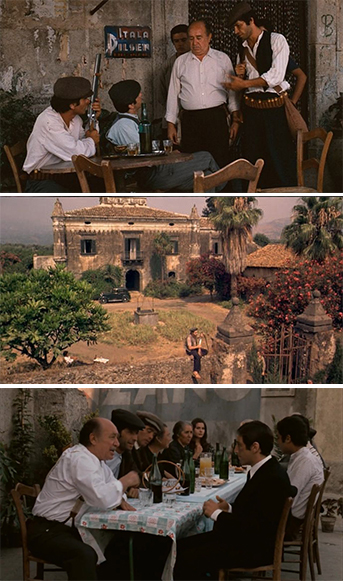 1:43:19 Michael is in Sicily. He has just met Apollonia Vitelli while on a walk to Corleone, the village of his father’s birth. Acting on Apollonia’s father’s invitation, Michael departs his hiding place—with food and two bodyguards in tow—in a car to meet the Vitelli family. The scene is shot through the gates of the safe-house. The camera follows the car down the road. Significance: The shot presents another example of the outside world vs. inside the “Corleone family” world. In this scene Michael leaves the protection of his “safe-house” to meet for the first time the young woman he ultimately marries. The counterpoint is that Apollonia meets Michael while surrounded by the safety of her family. The gate of the safe-house is the entrance to the beginning of this relationship between Michael and Apollonia.
1:43:19 Michael is in Sicily. He has just met Apollonia Vitelli while on a walk to Corleone, the village of his father’s birth. Acting on Apollonia’s father’s invitation, Michael departs his hiding place—with food and two bodyguards in tow—in a car to meet the Vitelli family. The scene is shot through the gates of the safe-house. The camera follows the car down the road. Significance: The shot presents another example of the outside world vs. inside the “Corleone family” world. In this scene Michael leaves the protection of his “safe-house” to meet for the first time the young woman he ultimately marries. The counterpoint is that Apollonia meets Michael while surrounded by the safety of her family. The gate of the safe-house is the entrance to the beginning of this relationship between Michael and Apollonia.
1:46:23 Sonny Corleone is seen leaving his mistress, Lucy Mancini, on the second floor of an apartment building. Accompanied by several bodyguards, he goes through the front door of the building to the street and a waiting car. As he leaves he remarks, “I have to go pick up my sister.” Significance: Yet another example of a door closing as an end to a scene.
1:46:35 In the very next scene Sonny comes through the front door of his sister Connie’s apartment only to find that she has been beaten by her husband, Carlo Rizzi, whom, ironically, introduced the couple to each other. Significance: Again, an example of Coppolla’s use of a door to open a scene.
1:55:22 This is the scene that instigates Sonny’s desire to again get physical with Carlo. In this scene Connie inadvertently discovers that Carlo is going out to meet with a girlfriend. She smashes dishes, threatens him with a knife. He chases her into the bathroom. Pushing against the bathroom door that Connie attempts to close. He kicks it down and enters the bathroom with his belt in hand intent on beating her again. The door to the bathroom swings open and then closes. We hear the beating and Connie’s screams. Significance: The door serves as a barrier between the beating and the audience. Connie’s screams are more penetrating when we don’t actually see what’s going on. Interestingly, the bathroom door has a mirror on it. When the door swings open we very briefly see what’s going on inside the bathroom. But then it quickly closes again and we are spared having to actually see the abuse in progress.
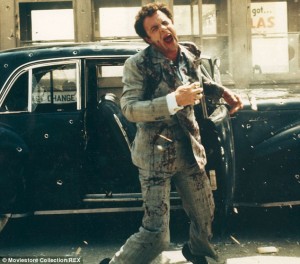 1:57:00 Connie calls Sonny and reports her latest beating to him. This motivates the hot-headed Sonny to come after Carlo. He leaves the compound by car. This dissolves to the tollgate on the highway. When the attendant at the tollgate kneels down to ostensibly pick something up and closes the door to his booth, several hitmen with machine guns from a parallel tollbooth and a car behind Sonny’s car reveal themselves and shoot Sonny with unrelenting fury. Significance: The physical context provides the opportunity for the assassination. The gates of the tollbooth (and the car behind him) prevent Sonny from escaping. The gates (as another kind of door) also mark the end of his life. Not only does he pay for a toll, he also pays with his life.
1:57:00 Connie calls Sonny and reports her latest beating to him. This motivates the hot-headed Sonny to come after Carlo. He leaves the compound by car. This dissolves to the tollgate on the highway. When the attendant at the tollgate kneels down to ostensibly pick something up and closes the door to his booth, several hitmen with machine guns from a parallel tollbooth and a car behind Sonny’s car reveal themselves and shoot Sonny with unrelenting fury. Significance: The physical context provides the opportunity for the assassination. The gates of the tollbooth (and the car behind him) prevent Sonny from escaping. The gates (as another kind of door) also mark the end of his life. Not only does he pay for a toll, he also pays with his life.
1:58:18 Tom Hagen is sitting in a living room in the Corleone household nursing a drink. We see him through the doorway leading to the living room. Vito Corleone—now sufficiently recovered from his attempted assassination wounds–enters the room from the right side of the camera. In this scene Hagen informs Vito that Sonny has been shot and killed. Significance: The opening and closing of this scene is shot from outside the room in the hallway. It serves as the entrance and exit of Vito Corleone. The conversation is shot inside the room. Again, the concept of outside and inside is conveyed. As we see Vito exiting the room and very slowly climbing the stairs, we hear Tom calling the undertaker—Bonasera, the very first character seen at the beginning of the film—instructing him to meet Don Corleone at his establishment in an hour. Interestingly “buona sera” in Italian means “Good evening.”
2:01:21 The very next scene is in the basement of the funeral parlor. We are brought into it from Vito’s point of view in the elevator through the sliding gate (i.e., door). The elevator is descending from the first floor to the basement. Significance: Not only the sliding gate, but also the fact that the elevator is going down to the basement conveys the feeling of a low point in Vito Corleone’s life. Sonny was his first child. The descent into the funeral parlor basement is a metaphor for Vito’s descent into a kind of purgatory—a pain he’ll have to live with for the rest of his life. The opening of the sliding gate to greet the funeral parlor director is Vito’s step into a kind of hell that he needs to deal with.
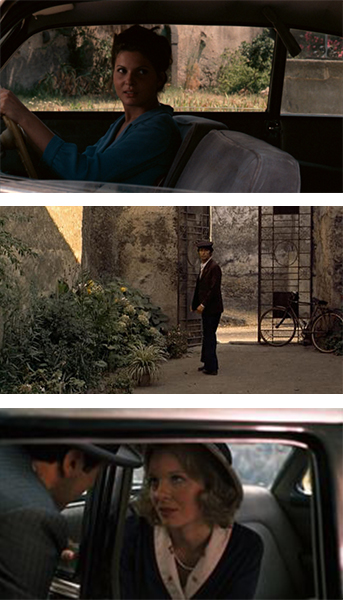 2:05:00 Michael is about to leave for a drive with his wife, Apollonia, who has been practicing to drive. We see her in the car with the safe-house gate in the background. We then see a brief shot of Fabrizio, one of Michael’s two bodyguards, hurriedly leaving the safe-house through the gates. Michael soon realizes that something is a foot. At that moment, a bomb explodes in the car, instantly killing Apollonia. Significance: The use of the gate (i.e., the door) to the safe-house courtyard is an echo of the earlier scene where Michael leaves (in a car) to meet Apollonia in a formal setting. In that scene the car is shot from outside the walls of the safe-house. In the scene where the car explodes, the audience sees the action from inside the walls of the safe-house from Michael’s perspective.
2:05:00 Michael is about to leave for a drive with his wife, Apollonia, who has been practicing to drive. We see her in the car with the safe-house gate in the background. We then see a brief shot of Fabrizio, one of Michael’s two bodyguards, hurriedly leaving the safe-house through the gates. Michael soon realizes that something is a foot. At that moment, a bomb explodes in the car, instantly killing Apollonia. Significance: The use of the gate (i.e., the door) to the safe-house courtyard is an echo of the earlier scene where Michael leaves (in a car) to meet Apollonia in a formal setting. In that scene the car is shot from outside the walls of the safe-house. In the scene where the car explodes, the audience sees the action from inside the walls of the safe-house from Michael’s perspective.
2:15:45 Not more than 10 minutes later in the film, Michael has returned to America and greets Kay as she leads a group of children at a primary school. Over the course of several minutes, Michael convinces Kay to rejoin him in the relationship. The deal is sealed when Kay enters Michael’s car through the car door that Michael opens for her. Significance: Michael loses his wife Apollonia in a car bomb explosion with the gate of his Sicilian safe-house in the background. Michael re-establishes his previous relationship with Kay and gains her emotional approval for a future marriage. The scene is punctuated by her entering a car. There is also an interesting juxtaposition of colors between the two cars. Apollonia’s car is brown, a warmish color set in a summery, sunny season. The later scene with Michael and Kay is the reverse. The car is black, even Michael is dressed in all, very formal black clothing, and the season is fall. The closing of the car door behind Michael and Kay also ends the scene, as usual.
2:25:20 We see several expensive cars coming into the Corleone compound from inside the compound. The next shot is inside the car carrying Michael, Kay and their infant son, Tony. As Michael exits the car Kay stops him and conveys a message from his sister, Connie—who is too afraid to ask. The request is for Michael to serve as Connie’s baby’s godfather. This conversation takes place with Michael outside the door of the car and Kay still inside the car. Significance: Metaphorically, Kay is still confined in her action (inside the car) while Michael is much freer in his ability to take action (outside the car).
2:32:27 Vito Corleone has died. This scene is the beginning of the burial service. We see all the funeral cars entering the cemetery from outside its gates. Significance: We know immediately that what will follow is the burial service.
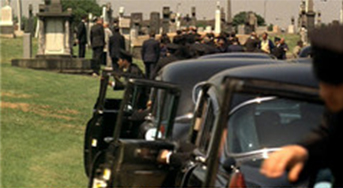 2:32:50 The limousines of the heads of the other “families” are lined up on the cemetery road where the burial will take place. All the doors are opened at once and the heads of the other families are escorted out of the cars, red roses in hand. Significance: We get a strong sense of the magnitude of the number of families coming to pay tribute to Vito Corleone. However, the tribute is in actuality a ruse. Late in the scene, Tessio tells Michael (now head of the family) that Emilio Barzini wants a meeting. Tessio, of course, turns out to be the traitor that Vito warned Michael of in a previous scene in the outside garden.
2:32:50 The limousines of the heads of the other “families” are lined up on the cemetery road where the burial will take place. All the doors are opened at once and the heads of the other families are escorted out of the cars, red roses in hand. Significance: We get a strong sense of the magnitude of the number of families coming to pay tribute to Vito Corleone. However, the tribute is in actuality a ruse. Late in the scene, Tessio tells Michael (now head of the family) that Emilio Barzini wants a meeting. Tessio, of course, turns out to be the traitor that Vito warned Michael of in a previous scene in the outside garden.
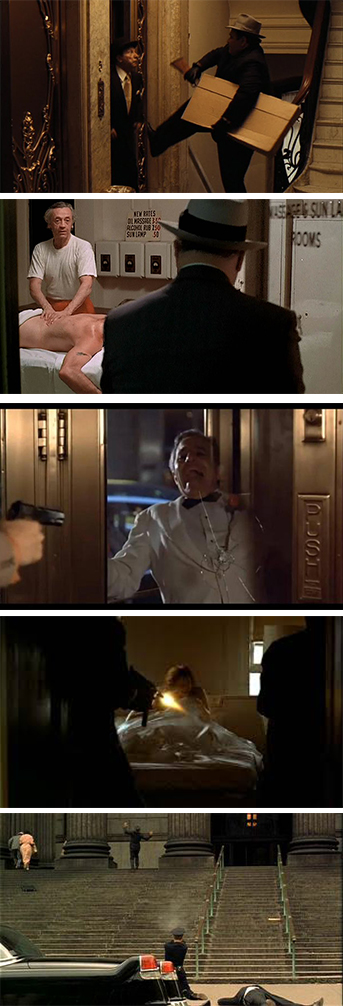 2:40:05 Clemenza climbs several flights of stairs to confront one of the heads of the “enemy families.” He murders him with a shotgun through the door of an elevator as he is about to exit it.
2:40:05 Clemenza climbs several flights of stairs to confront one of the heads of the “enemy families.” He murders him with a shotgun through the door of an elevator as he is about to exit it.
2:40:12 An unidentified hitman kills Moe Greene through his right eye through the door of a massage room where Greene is lying on his stomach for a massage.
2:40:29 Willie Cicci traps another head of one of the enemy families in a revolving door in a hotel lobby and shoots him with a handgun.
2:40:35 Two hitmen burst through the door of what appears to be a hotel room and kill Tattaglia and a woman who are lying in bed having sex. They use machine guns for the kills.
2:40:45 Al Neri (Michael Corleone’s closest bodyguard) dressed as policeman kills Bazini’s driver and bodyguard and then kills Bazini as he attempts to escape by running up the steps of a building (reminiscent of the court house in downtown Manhattan. How ironic!)
Four of the five scenes above employ doors as part of the successful assassinations. Only in the case of the Al Neri/Bazini kill do the kills occur outside. The only door attached to this scene is when Neri jumps into a car through the car door to make his getaway.
2:44:07 Michael makes an entrance through a door to one of the rooms in the Corleone compound where he confronts Carlo (Connie’s abusive husband). Michael is accompanied by several men, including Al Neri and Tom Hagen. Michael presses Carlo about Bazini and his brother Sonny’s murder. Carlo confesses that Bazini approached him to set up the “beating” with Connie that they knew would provoke Sonny into a hot-headed reaction. Carlo is given plane tickets and escorted to a waiting car. When he gets in Clemenza garrotes him. Significance: The door to this particular section of the compound is used as an “entrance” to what becomes the penultimate denouement of the film.
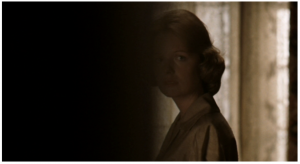 2:51:47 Michael has just told Kay that he did not order Carlo’s killing. She naively accepts his word. This closing scene shows Kay leaving the room where she had just spoken with Michael where she walks down the hallway. In this long shot, Kay is foreground, but out of focus—a reflection of her naïveté. We then get a medium shot—still from the hallway—through the door of the room. In the room are several men, including Clemenza and Al Neri who, by kissing Michael’s hand, acknowledge his assumption of godfather of the Corleone family. As Neri goes to close the door to the room, the point of view switches to Kay looking somewhat saddened into the room. We see the door close (again from right to left) against Kay’s dejected look. The visual effect is actually a wipe. As the picture becomes black the music also does not resolve. Significance: The closing of the door, which in previous scenes had been used to end a scene, is here used to end the film itself. It also speaks loudly that Kay, despite being Michael’s wife and presumably his closest relationship, is, in reality, not in the inner circle of the Corleone family, but is, for all intents and purposes, a functional wife, but not a partner.
2:51:47 Michael has just told Kay that he did not order Carlo’s killing. She naively accepts his word. This closing scene shows Kay leaving the room where she had just spoken with Michael where she walks down the hallway. In this long shot, Kay is foreground, but out of focus—a reflection of her naïveté. We then get a medium shot—still from the hallway—through the door of the room. In the room are several men, including Clemenza and Al Neri who, by kissing Michael’s hand, acknowledge his assumption of godfather of the Corleone family. As Neri goes to close the door to the room, the point of view switches to Kay looking somewhat saddened into the room. We see the door close (again from right to left) against Kay’s dejected look. The visual effect is actually a wipe. As the picture becomes black the music also does not resolve. Significance: The closing of the door, which in previous scenes had been used to end a scene, is here used to end the film itself. It also speaks loudly that Kay, despite being Michael’s wife and presumably his closest relationship, is, in reality, not in the inner circle of the Corleone family, but is, for all intents and purposes, a functional wife, but not a partner.
If you have any questions or comments about this or any other of my blogs, please write to me at meiienterprises@aol.com.
Eugene Marlow, Ph.D.
November 23, 2015
© Eugene Marlow 2015


